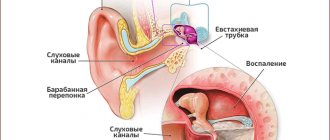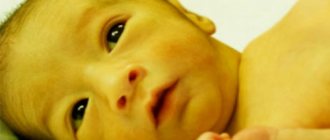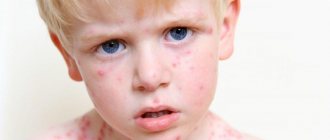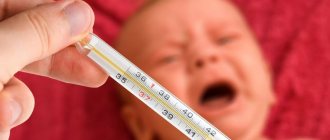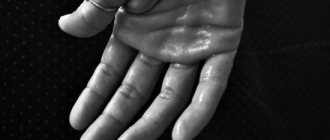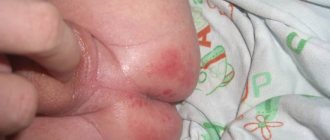Clinical picture of the disease
It is very difficult to get rid of the disease in an advanced stage, which is why it is so important to recognize dermatomycosis at the initial stage. It is important to pay attention to the integrity of the skin, the presence of wounds, cracks, dryness and flaking of the skin, redness or changes in the structure of the epidermis.
Attention!
Children may complain of itching and pain in the area where mycosis occurs. A child's foot fungus hinders the baby's mobility and prevents him from walking and running. In rare cases, there is an increase in body temperature up to 38 degrees, general weakness, and increased activity of the sebaceous glands.
Unlike adults, onychomycosis in children does not manifest itself for a long time, the nail plates do not change color, and the affected nail becomes loose and begins to crumble only in an advanced stage.
Remedies for the treatment of foot fungus in children
Other means
Also, for effective treatment, you can take various compresses and rubbing. For example, when asking the question: “How to treat foot fungus in a 7-year-old child or another age?”, the following options are suitable:
- If certain areas of the body are affected by a fungal infection, rub with a mixture of garlic and butter in equal proportions.
- You can chop the onion into small pieces, wet it and rub the affected part of the body.
- A compress of rowan or burdock leaves is also used. At night, you should wrap your feet with the leaves of these plants and cover them with a cotton cloth or sock.
- If the nail plate is damaged, iodine solution or tea tree oil will help.
Causes of fungal infection in a child
Children's foot fungus manifests itself due to various factors - contact with infected people, through household items, prolonged exposure to a humid environment, wearing poor-quality shoes, and insufficient hygiene of the whole body.
The disease can manifest itself during a seasonal decrease in the body's defenses, with a deficiency of vitamins and microelements, or after an antibacterial attack on the child's body.
Another reason is mechanical trauma to the skin of the feet, when pathogenic microorganisms penetrate through cracks and abrasions, leading to the development of onychomycosis.
Varieties of the disease
Depending on the location of the pathology on the foot, the disease can be of the following types:
- Interdigital mycosis. Most often observed in patients in acute or chronic form.
- Plantar mycosis. As a rule, this type is manifested by keratinization and peeling of the foot.
- Deep mycosis. With this disease, we are talking about damage not only to the surface of the skin, but also to deeper layers.
- Dyshidrotic dermatophytosis. This type is visually similar to allergic dermatitis. The skin of the foot becomes covered with vesicles and blisters.
- Onychomycosis. Characterized by damage to the fingers and toenails.
Forms of fungus
There are 4 forms of fungal infection in children:
- Interdigital, when the funnel between the toes suffers (dries out, itches, becomes covered with small scales, the stratum corneum hardens);
- Athletic foot – looks as if sprinkled with flour, the skin becomes rough, and the nails lose their natural color, become yellow, brown, and resemble a bird’s beak in shape;
- Vesicular - the formation of small bubbles and blisters, the danger of the disease is the addition of a secondary infection, the disease can become chronic, spreading throughout the body;
- Erased - the fungus on the skin of a child’s feet is not identified at the initial stage, it “hides” in the folds between the toes, subsequently a rash and swelling appear, and the configuration of the nail changes.
A photo of fungus on children's feet illustrates the possible serious consequences of exposure to pathogenic microorganisms. Only a specialist can confirm or refute mycosis; diagnosing the disease and treating it is strictly prohibited in order to avoid the development of serious complications.
Forms of fungal infection on the feet of children
Signs of fungus in the interdigital spaces
When wearing low-quality or unventilated shoes, intense sweating of the feet occurs. This leads to swelling of the skin surface, erosions, and cracks. The main complaints of patients are: burning sensation, soreness, unbearable itching.
Over time, the patient's condition worsens. Foot fungus begins to progress. Each patient should discuss symptoms and treatment only with a doctor.
A more advanced form is characterized by increased pain and itching. These sensations are most sensitive during movement. The formation of large bubbles can be observed in the spaces between the fingers. Later they turn into erosions. A characteristic feature is a whitish border around the damaged area.
Treatment of fungus in a child
Before treating a child’s foot fungus, it is important to collect a medical history, see a doctor for a visual examination and identify the characteristic symptoms of the disease. Scraping of damaged tissue is studied, and the polymerase chain reaction method is additionally used to determine the gene of the pathogen.
Important!
When the diagnosis is confirmed, treatment of fungus on the child’s feet between the toes is carried out comprehensively, antifungal drugs are prescribed for internal and external use.
In severe cases, detoxification therapy is carried out, aimed at cleansing the body of fungal waste products. Saline solutions and sorbents, immunomodulators are used to strengthen the body's defenses and prevent re-infection.
Depending on the type of fungal infection, medications are selected. Treatment of foot fungus in children - popular remedies:
- Systemic antifungals - Terbinafine, Diflucan, Nimzoral, to prevent the spread of infection throughout the body, have a detrimental effect on the cell membranes of pathogenic forms. The treatment regimen and dosage are selected by the attending doctor; the standard course is 4-8 weeks.
- Ointments, gels, topical creams - Exoderil, Clotrimazole, Miconazole, are intended for external use, applied to the affected areas in a thin layer 2 times a day, the duration of treatment is up to 2 months. For preventive purposes, skin and nails should be treated for another 7 days after the signs of the disease disappear.
- Itraconazole and ketoconazole are hepatoxic drugs (increase the resistance of liver cells to pathogens), have a wide spectrum of action, and effectively eliminate toenail fungus in a child. Strictly prescribed by a doctor.
Medicines for the treatment of foot fungus in children
In case of extensive damage to the skin, antifungal drugs are used together with antibacterial drugs. All medications for foot fungus are prescribed to children after 2 years of age, before this age - maintenance therapy.
Causes of the disease
The causes of the disease are:
- Violation of personal hygiene. You need to tell your child all the time that you can’t walk barefoot in public places (bathhouse, sauna, swimming pool).
- Wearing shoes that are too narrow. When the legs are compressed, sweating occurs, inflammation increases, which provokes infection with fungal diseases.
To maintain health, children need to wear comfortable shoes made from natural materials.
- Synthetic socks and shoes made of rubber or polymers cause sweaty feet and interfere with the breathing of the skin. This creates an excellent environment for pathogens to spread.
Important! Parents of children with diabetes should be especially attentive to the problem. These babies produce glucose along with sweat. Various fungi love to multiply in such an environment.
- Abrasions and scratches on the sole, long uncut nails contribute to the development of inflammation and the appearance of foot fungus in children.
- Children suffering from flat feet or vascular diseases of the legs are also at risk.
- Foot fungus in children multiplies in a warm, humid environment. After all bath procedures, the child’s feet should be thoroughly dried.
- Adult family members suffering from foot fungus have every chance of infecting the baby living with them, whose immune system has not yet formed all the protective functions of the body.
Treatment of fungus is a very long and painstaking process. However, the fungus will not go away on its own. The disease can become chronic. A dermatologist will suggest an effective and age-appropriate treatment.
Traditional treatment
You can eliminate the symptoms of the disease using traditional medicine recipes. Before starting medical procedures, you must consult your doctor regarding the effectiveness of a particular prescription, the presence of side effects and contraindications.
You can cure fungus on children's toes using various baths:
- Steam the legs in a decoction of milkweed - pour a glass of boiling water over a spoonful of raw materials, keep in a water bath for 5 minutes, cool, dilute with 2 liters of water, and begin the procedure;
- Immerse the foot in a decoction of wormwood for 10 minutes - 2 tablespoons of herb per 1 liter of water, boil the mixture over low heat for 20 minutes (the bath helps eliminate itching and relieve inflammation);
- Steam your feet in brewed coffee three times a day, after 2 weeks the symptoms of the fungus will disappear.
Ingredients for folk antifungal remedies
Effective compresses and ointments
To cure a child’s fingers from a fungal infection, it is necessary to make medicinal compresses daily from onion or garlic pulp, grinding the heads and mixing the raw material with sunflower oil in equal proportions. Rub the peeling areas before going to bed, duration of therapy is 2 weeks.
If the fungus bothers the baby at night, then there is an effective method to eliminate the itching - rub the feet with salicylic ointment, and then wrap the feet with polyethylene and put on a warm sock on top. In the morning, remove the compress.
Treatment with soda
This cheap and affordable remedy will help get rid of the fungus once and for all. It is enough to dilute a tablespoon of powder with a small amount of water until a creamy consistency is obtained, then apply a generous layer to the interdigital areas, damaged skin, and nails.
After 10 minutes, rinse with warm water and wipe your feet dry with a towel. Treat with additional powder or cornstarch. The duration of therapy is 2 weeks; after a week of break, the procedure can be repeated.
Laser therapy
One of the effective and side-effect-free methods of treating onychomycosis is laser. The laser beam acts precisely on the mycelium of the fungus and its protein structures. When exposed to high temperatures, they completely denature (destroy). The fungus is completely destroyed.
During the procedure, the patients did not experience any discomfort. According to clinical studies in 2015, this method allows you to get rid of fungus in 98% of cases. No side effects were recorded. The essence of the method:
- The laser precisely targets the mycelium of the fungus without damaging healthy tissue.
- Painless procedure. Many modern laser machines are equipped with a device for a flow of cold air, which cools the area being treated.
- Effectiveness after the first procedure.
- The duration of the procedure is no more than 15 minutes.
Laser therapy is used to remove damaged nail plates. Positive qualities of this method: sterilization of the wound, sanitation of the bed - when exposed to high temperatures, pathogenic microorganisms die; impossibility of infection with hepatitis or HIV through blood through contact with medical instruments; blood loss is minimal. Laser therapy is used for people who suffer from bleeding disorders. To effectively treat onychomycosis, you need to complete a course of 4-5 sessions. The exact number and duration of the procedure is strictly individual.
Contraindications for this method:
- It is strictly forbidden to use after a long stay in sunlight (after a vacation at the seaside or in the country), after visiting a solarium.
- Vascular atherosclerosis.
- Epilepsy, other central nervous system disorders.
- Diabetes mellitus type 1.
Before the laser therapy procedure, you need to take a salt bath for your feet. Afterwards, wash your feet with soapy water. Nails need to be trimmed and any remaining ointment or varnish removed.
Fungus prevention
How to avoid fungal infections in the body of children and adults? Preventive measures:
- carefully observe the rules of personal hygiene;
- wear slippers in public places, watch your child so that he does not wear someone else’s shoes;
- choose shoes from breathable and natural fabrics;
- once a month, treat the insoles and the inside of shoes with disinfectant compounds;
- control the temperature of your feet to avoid overheating and sweating;
- strengthen the baby’s immunity, introduce more vegetables and fruits into food, drink at least 1-1.5 liters of fluid per day.
If signs of a violation of the integrity of the skin or damage to the structure of the nail plate appear, immediately contact a specialized doctor, and carry out treatment under the supervision of a specialist.
Healthy legs are the key to excellent health, preservation of beauty and youth of the whole body.
How dangerous is a mycotic infection for a child?
It is necessary to treat mycosis of the feet immediately after the first symptoms of the pathology appear. Late diagnosis can lead to the following complications:
- allergic reaction of the skin and mucous membranes (allergic dermatitis),
- disruption of the epidermal regeneration process,
- severe course of other dermatological diseases (psoriasis, eczema, dermatitis of various etiologies), exacerbation of erysipelas,
- suppuration, lymphostasis in case of bacterial infection,
- increased frequency of manifestations of human papillomavirus (warts) by 4 times,
- formation of large calluses, hyperkeratosis.
The prolonged course of mycosis of the feet leads to the spread of the fungus to the nails, hands and skin of the entire body.
Features and contraindications
The most effective treatment for mycosis in children is combination therapy - drugs for internal use and local remedies. But such a move does not always bring benefits.
If in older children the choice of medications is limited by contraindications, individual for each case, then in infants everything is more complicated:
- systemic treatment is contraindicated for up to 2 years;
- complex therapy is not used for liver diseases;
- medications can cause more harm to babies than the fungus itself;
- for children under 2 years of age, only maintenance therapy is acceptable.
If an infant has mycosis, you will have to wait until he is old enough so that taking medications does not cause more harm than good.

